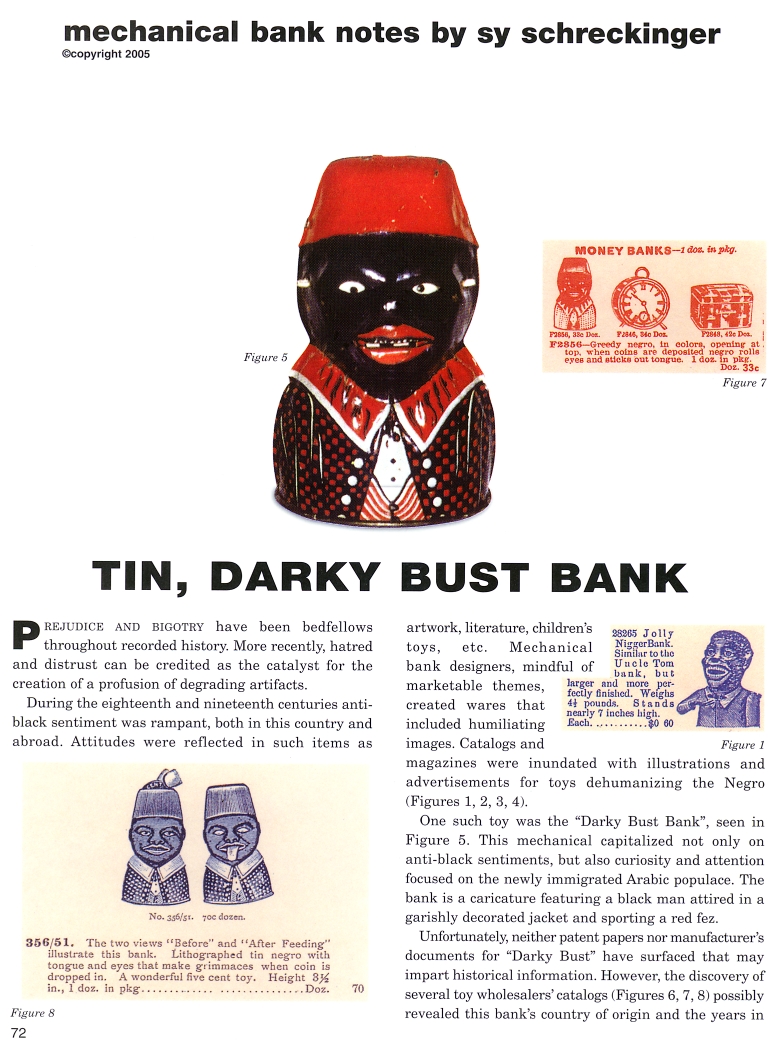|
Tin, Darky Bust Bank
by Sy Schreckinger – ANTIQUE TOY WORLD Magazine – November, 2005
Prejudice and bigotry have been bedfellows throughout recorded
history. More recently, hatred and distrust can be credited as the
catalyst for the creation of a profusion of degrading artifacts.
During the eighteenth and nineteenth centuries anti-black sentiment
was rampant, both in this country and abroad. Attitudes were reflected in
such items as artwork, literature, children's toys, etc. Mechanical bank
designers, mindful of marketable themes, created wares that included
humiliating images. Catalogs and magazines were inundated with
illustrations and advertisements for toys dehumanizing the Negro (Figures
1, 2, 3, 4).
One such toy was the "Darky Bust Bank", seen in Figure 5. This
mechanical capitalized not only on anti-black sentiments, but also
curiosity and attention focused on the newly immigrated Arabic populace.
The bank is a caricature featuring a black man attired in a garishly
decorated jacket and sporting a red fez.
Unfortunately, neither patent papers nor manufacturer's documents for
"Darky Bust" have surfaced that may impart historical information.
However, the discovery of several toy wholesalers' catalogs (Figures 6, 7,
8) possibly revealed this bank's country of origin and the years in which
it was distributed. The lack of patent information is attributed to early
German patent laws. It was government mandated that unimportant patents,
including toys, were to be routinely discarded after fifteen years of
issuance, thus depriving the item of its heritage.
The "Darky Bust Bank" (Figure 5) is one of two rare mechanicals
believed to have been manufactured and/or distributed by Maienthau and
Wolff of Nurnberg, Germany. Interestingly, the Maienthau and Wolff catalog
(Figure 6) does not picture the subject of this article, but rather
another mechanical entitled "Mandarin Bank". This mechanical is similar in
construction, materials, action and size to "Darky Bust", differing only
in subject matter. These striking similarities have led many collectors
and historians to assume a relationship between both mechanical banks and
also to Maienthau and Wolff.
Figure 7 depicts a Butler Brothers, U.S.A., toy wholesaler's catalog,
circa 1905. In it is an advertisement for the "Greedy Negro" Bank (a.k.a.
"Darky Bust"), with a selling price of 33 cents per dozen. Figure 8 is a
Nerlich and Company, U.S.A. trade catalog, circa 1907, offering the "Tin
Negro" Bank for 70 cents per dozen.
The "Darky Bust" is constructed entirely of brightly lithographed
tinplate. Operation is accomplished by inserting a coin through the slot
atop the fez. As the coin descends, the Darky's eyes tilt upward and its
tongue protrudes. Deposits are removed by literally cutting out the
tinplate bottom of the bank with a can opener (there is no simple means of
coin removal built in by the manufacturer).
"Darky Bust Bank" is extremely rare. Its radical method of coin
extraction, delicate mechanism and extremely fragile tinplate construction
explain its scarcity.
There are no variations of "Darky Bust" other than its attire. Our
subject may be clothed as pictured in Figure 5, or wearing a
yellow-checkered jacket and vest and a yellow fez.
I am not aware of the existence of reproduced examples of "Darky
Bust". However, in view of its fragile nature there is the possibility of
restored or replaced parts. As with any rare, delicate antique, limited
professional conservation may be considered acceptable without
significantly devaluing the object.
"Darky Bust" is miniscule in size: Height: 3-11/16 inches; Width:
2-3/16 inches. This does not diminish its desirability. In addition to its
aforementioned rarity, "Darky Bust" is most attractive and an enhancement
to a mechanical bank collection.
Acknowledgement: The mint example "Darky Bust Bank", Figure 5, is
from the collection of Robert Weiss.
|

